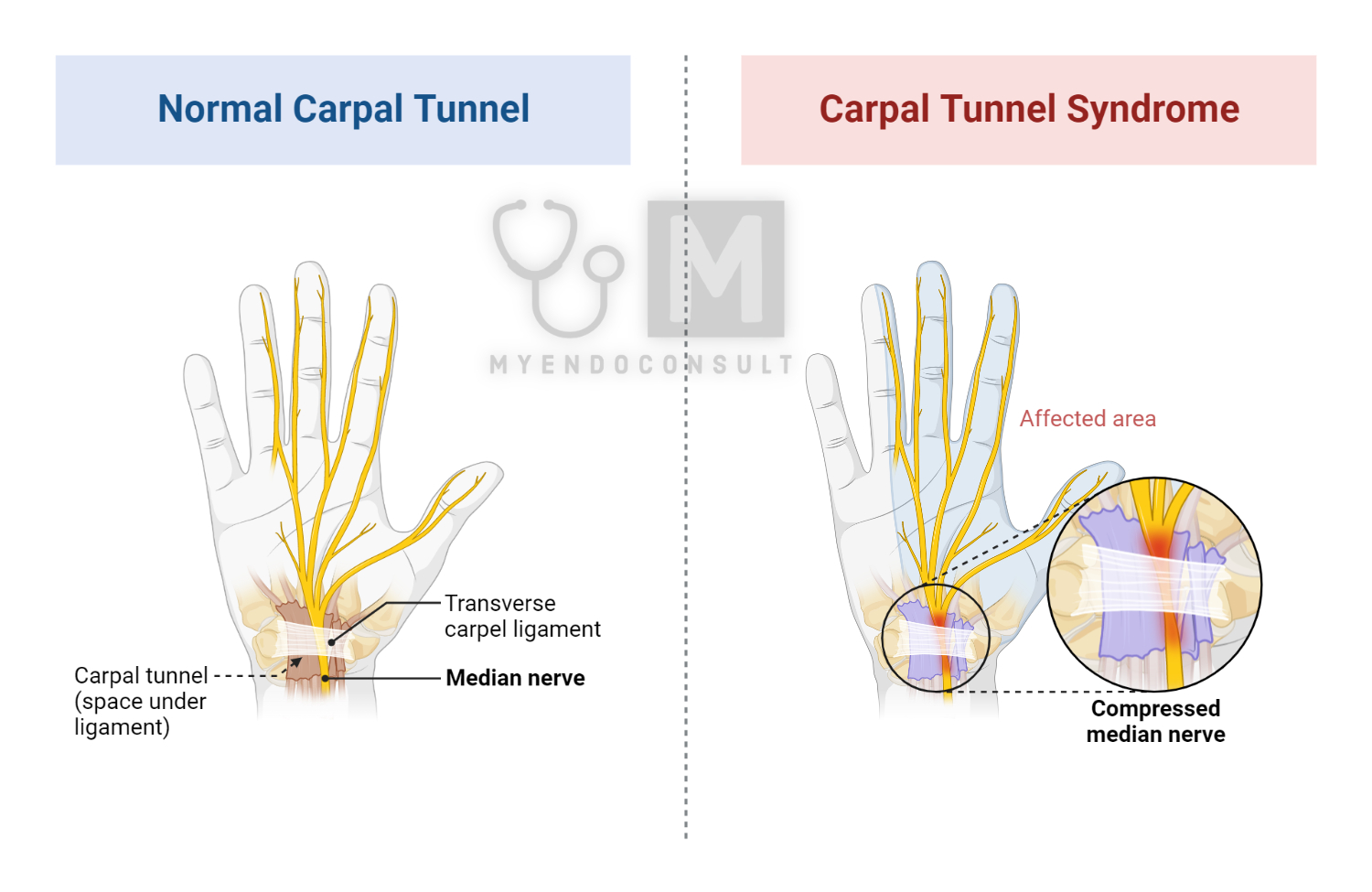Tinel's sign is a clinical test used to identify entrapment of the median nerve in the carpal tunnel, which is a common cause of carpal tunnel syndrome (CTS). This article reviews the technique, diagnostic accuracy, and clinical significance of Tinel's sign in the context of diagnosing CTS.
Understanding Carpal Tunnel Syndrome
Carpal tunnel syndrome is a common neuropathy characterized by compression of the median nerve as it passes through the carpal tunnel in the wrist. This compression can result in symptoms such as pain, numbness, tingling, and weakness in the affected hand and fingers. Risk factors for CTS include repetitive hand movements, wrist injuries, certain medical conditions (eg, diabetes, rheumatoid arthritis), and genetic predisposition.

Technique for Performing Tinel's Sign
To perform Tinel's sign, follow these steps:
- Have the patient comfortably seated, with their elbow flexed and forearm fully supinated.
- Begin by gently tapping with your finger on the area of the watch band on the median nerve, which is located on the volar aspect of the wrist.
- Continue percussing and move upward towards the palmar creases.
- Return back to the watch band area, then move radially towards the palmaris longus tendon.
- Observe the patient's response and ask him or her to report any tingling, numbness, or discomfort experienced during the test.
Interpreting the Results of Tinel's Sign
The results of Tinel's sign can be classified as either positive (abnormal) or negative (normal):
Positive test result: The patient experiences tingling paresthesia (ie, aching and numbness) over the palmar aspect of the hand, which may indicate entrapment of the median nerve in the carpal tunnel.
Negative test result: The patient does not experience any discomfort or abnormal sensations during the test, suggesting the absence of entrapment of the median nerve.
A brief video presentation of how to elicit Tinel's sign
Diagnostic Accuracy of Tinel Sign
The diagnostic precision of Tinel’s sign is a subject of debate, with studies reporting varying sensitivity and specificity rates. In general, Tinel’s sign is considered to have low sensitivity and specificity for the diagnosis of carpal tunnel syndrome.
A study by Seror (1987) reported that 63% of patients with electrophysiologically proven carpal tunnel syndrome had a positive Tinel test. However, it is important to note that there are considerable differences between and between examiners in the range of forces generated by the various Tinel techniques used in clinical practice. As such, the diagnostic accuracy of Tinel’s sign can be influenced by the examiner’s experience of the examiner and the specific technique used.
Clinical Significance and Limitations
It should be noted that Tinel's sign is a valuable diagnostic tool for the initial assessment of patients with suspected carpal tunnel syndrome, as it can help identify the presence of entrapment of the median nerve in the carpal tunnel. However, it is essential to recognize the limitations of Tinel's sign, as its diagnostic accuracy may be affected by the examiner's technique and experience. Furthermore, a positive Tinel sign alone is insufficient to confirm the diagnosis of CTS, as other conditions (eg, tenosynovitis, wrist arthritis) can also cause similar symptoms.
In light of these limitations, it is crucial to consider the results of Tinel's sign in the context of the patient's overall clinical presentation and other diagnostic tests, such as nerve conduction studies, electromyography, and imaging studies. Furthermore, a complete history and physical examination should be performed to assess potential risk factors and comorbid conditions that can contribute to the development of carpal tunnel syndrome.
Alternative diagnostic tests for Carpal Tunnel Syndrome
In addition to Tinel's sign, other clinical tests can be employed to diagnose carpal tunnel syndrome, such as Phalen's and Durkan's tests. Next, we will briefly discuss both tests.
Phalen's test: This test involves having the patient flex their wrists maximally and hold the position for 30-60 seconds. A positive result occurs when the patient experiences numbness, tingling, or pain in the median nerve distribution, suggesting carpal tunnel syndrome.
Durkan's test (compression test): The examiner applies direct pressure to the median nerve in the carpal tunnel for 30-60 seconds. A positive result is indicated by the reproduction of the patient's symptoms in the median nerve distribution.
It is important to recognize that no single test is definitive for the diagnosis of carpal tunnel syndrome. The combination of clinical tests, history, physical examination, and electrodiagnostic studies should be used to establish the diagnosis and determine the appropriate management plan for each patient.
Management of Carpal Tunnel Syndrome
The treatment of carpal tunnel syndrome depends on the severity of the condition and the individual needs. Initial treatment typically involves conservative measures, such as activity modification, wrist splinting, non-steroidal anti-inflammatory drugs (NSAIDs) and corticosteroid injections. Such conservative measures aim to reduce inflammation and alleviate pressure on the median nerve.
Exercises and stretches targeting the wrist and hand may also help improve symptoms and prevent further compression of the median nerve.
Finally, in cases where conservative management fails or the condition is severe, surgical release of the transverse carpal ligament (carpal tunnel release) may be necessary to relieve pressure on the median nerve and provide long-term relief for the patient.
Conclusion
The Tinel sign is a useful diagnostic tool for assessing the presence of entrapment of the median nerve in the carpal tunnel, which is a common cause of carpal tunnel syndrome. However, it is important to recognize the limitations of Tinel's sign and consider its results in the context of the overall clinical presentation and other diagnostic tests. By understanding the technique, diagnostic accuracy, and clinical significance of Tinel's sign, you can improve your diagnostic skills and patient care in carpal tunnel syndrome management.
References
Seror P. Tinel's sign in the diagnosis of carpal tunnel syndrome. J Hand Surg Br 1987;12(3):364-5.
Bickley LS et al. Bates' Guide to Physical Examination and History Taking. 11th ed. Philadelphia, PA: Lippincott Williams & Wilkins. 2013;634.
Kindly Let Us Know If This Was helpful? Thank You!


